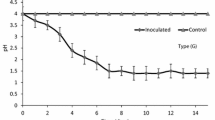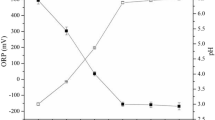Abstract
The partitioning of Mn, Al, Zn, Cu and Ti ions in municipal sewage sludge was investigated before and after bioleaching processes effectuated by Acidithiobacillus ferrooxidans and Acidithiobacillus thiooxidans. Oxidation–reduction potential increase and pH decrease were obtained as a result of bacterial activity. A less pronounced and constant decrease was obtained with A. ferrooxidans, whereas A. thiooxidans presented a lag phase before a steep pH decrease. Metal solubilization was accomplished in experimental systems supplemented with energy source, Fe2+ for A. ferrooxidans and S0 for A. thiooxidans. Solubilization efficiency differed for each metal except for Al, and was relatively similar for either organism. Metal partitioning was conducted using a five-step sequential extraction procedure before and after the bioleaching. The results indicated that Zn and Mn ions were mostly associated with the organic fraction, whereas Cu, Al and Ti ions with the sulphide/residue fraction. The bioleaching process caused prompt solubilization of metals mostly associated with the more labile fractions (exchangeable, adsorbed and organically bound metals), whereas those associated to the less labile ones (EDTA and sulphide/residue fractions) were exchanged towards more labile fractions.
Similar content being viewed by others
References
Adamu C.A., Bell P.F. and Mulchi C. (1989). Residual metal concentrations in soils and leaf accumulations in tobacco, a decade following farmland application of municipal sludge. Environmental Pollution 56: 113–126
Blais J.F., Tyagi R.D. and Auclair J.C. (1993). Bioleaching of metals from sewage sludge: effects of temperature. Water Research 27: 111–120
Chan L.C., Gu X.Y. and Wong J.W.C. (2003). Comparison of bioleaching of heavy metals from sewage sludge using iron- and sulphur-oxidizing bacteria. Advances in Environmental Research 7: 603–607
Chen S.Y. and Lin J.G. (2004). Bioleaching of heavy metals from contaminated sediment by indigenous sulphur-oxidizing bacteria in an air-lift bioreactor: effects of sulphur concentration. Water Research 38: 3205–3214
Couillard D. and Zhu S. (1992). Bacterial leaching of heavy metals from sewage sludge for agricultural application. Water, Air and Soil Pollution 63: 67–80
Couillard D. and Mercier G. (1991). Optimum residence time (in CSTR and airlift reactors) for bacterial leaching of metals from anaerobic sewage sludge. Water Research 25: 211–219
Epstein E. (1976). Effects of sewage sludge and sludge compost applied to soil on some soil physical and chemical properties. Journal of Environmental Quality 5: 422–426
(1991). Isolation and purification of Thiobacillus ferrooxidans and Thiobacillus thiooxidans from some coal and uranium mines of Brazil. Revista de Microbiologia 20: 1–6
Gu X.Y. and Wong J.W.C. (2004). Identification of inhibitory substances affecting bioleaching of heavy metals from anaerobically digested sewage sludge. Environmental Science and Technology 38: 2934–2939
Hue N.V. and Ranjith S.A. (1994). Sewage sludges in Hawaii: chemical composition and reactions with soils and plants. Water, Air and Soil Pollution 72: 265–283
Jain D.K. and Tyagi R.D. (1993). Factors affecting toxic metals removal from digested sludge by enriched sulphur-oxidizing microorganisms. Bioresource Technology 45: 33–41
(1991). A review of the agricultural use of sewage sludge: benefits and potential hazards. Water S.A. 17: 189–196
Lake D.L., Kirk P.W.W. and Lester J.N. (1985). The effects of anaerobic digestion on heavy metal distribution in sewage sludge. Water Pollution Control 84: 549
Lake , D.L. 1987 Chemical speciation of heavy metals in sewage sludge and related matrices. In Heavy Metals in Wastewater and Sludge Treatment Processes: Sources, Analysis and Legislation, ed. Lester, J.N., Vol. 1, pp. 125–153. Florida, USA: CRC Press. ISBN 0849346673.
Liu H.L., Chiu C.W. and Cheng Y.C. (2003). The effects of metabolites from the indigenous Acidithiobacillus thiooxidans and temperature on the bioleaching of cadmium from soil. Biotechnology and Bioengineering 83: 638–645
Lombardi A.T. (2002). Biological leaching of Mn, Al, Zn, Cu and Ti in an anaerobic sewage sludge effectuated by Thiobacillus ferrooxidans and its effect on metal partitioning. Water Research 36: 3193–3202
Lombardi A.T. (1999). An evaluation into the potential of biological processing for the removal of metals from sewage sludges. Critical Reviews in Microbiology 25: 275–288
Lombardi A.T. and Mozeto A.A. (2001). Bioleaching of metals from anaerobic sewage sludge: effects of total solids, leaching microorganism and energy source. Journal of Environmental Science and Health A36: 793–806
Ngiam L.-S. and Lim P.-E. (2001). Speciation patterns of heavy metals in tropical estuarine anoxic and oxidized sediments by different sequential extraction schemes. Science of the Total Environment 275: 53–61
Oake R.J., Booker C.S. and Davis R.D. (1984). Fractionation of heavy metals in sewage sludge. Water Science and Technology 17: 587–598
Rapin F., Tessier A., Campbell P.G.C. and Carignan R. (1986). Potential artifacts in the determination of metal partitioning in sediments by a sequential extraction procedure. Environmental Science and Technology 20: 836–840
Ravishankar B.R., Auclair J.C. and Tyagi R.D. (1994). Partitioning of heavy metals in some Quebec municipal sludges. Water Pollution Research Journal of Canada 29: 457–470
Rudd,T., Lake, D.L. Kirk, P.W.W. & Lester, J.N. 1985 Chemical fractionation of heavy metals in sewage sludges. 2nd Report Wat Res Centre, Medmenham U.K. Cited in Lake (1987).
Silverman M.P. and Lundgren D.G. (1959). Studies on the chemoautotrophic iron bacterium Ferrobacillus ferrooxidans. I. An improved medium and a harvesting procedure for securing high cell yields. Journal of Bacteriology 77: 642–647
Stover R.C., Sommers L.E. and Silviera D.J. (1976). Evaluation of metals in wastewater sludge. Journal of Water Pollution Control Federation 48: 2165–2175
Tack F.M.G., Singh S.P. and Verloo M.G. (1999). Leaching behaviour of Cd, Cu, Pb and Zn in surface soils derived from dredged sediments. Environmental Pollution 106: 107–114
Tsai L.J., Yu K.C., Chen S.F. and Kung P.Y. (2003). Effect of temperature on removal of heavy metals from contaminated river sediments via bioleaching. Water Research 37: 2449–2457
Tuovinen O.H. (1973). Studies on the growth of Thiobacillus ferrooxidans. Use of membrane filters and ferrous iron agar to determine viable number and comparison 14CO2-fixation and iron oxidation as measures of growth. Archives of Microbiology 88: 285–298
Tyagi R.D., Couillard D. and Tran F.T. (1990). Studies on microbial leaching of heavy metals from municipal sludge. Water Science and Technology 22: 229–238
Tyagi R.D., Blais J.F., Meunier N. and Benmoussa H. (1997). Simultaneous sewage sludge digestion and metal leaching – effect of sludge solids concentration. Water Research 31: 105–118
Vooneburg F. (1993). Treatment and disposal of municipal sludge in the Netherlands. Journal of the International Water E.M. 7: 116–121
Author information
Authors and Affiliations
Corresponding author
Rights and permissions
About this article
Cite this article
Lombardi, A.T., Garcia, O. & Menezes, W.A.N. The Effects of Bacterial Leaching on Metal Partitioning in Sewage Sludge. World J Microbiol Biotechnol 22, 1013–1019 (2006). https://doi.org/10.1007/s11274-005-2889-1
Received:
Accepted:
Published:
Issue Date:
DOI: https://doi.org/10.1007/s11274-005-2889-1




